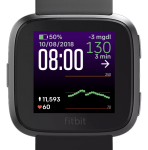I use a lot of technology in my day-to-day life, but it’s concerning how much of it is not as robust as I would like.
For example many of the tools we use assume that we will always have an Internet connection. But even today that assumption is not always true.
 To some people “no Internet” means freedom from social media, work emails, etc. That can be great. But if it means your medical devices stop working properly that can be a problem! Especially if it’s the closed-loop system controlling your insulin administration.
To some people “no Internet” means freedom from social media, work emails, etc. That can be great. But if it means your medical devices stop working properly that can be a problem! Especially if it’s the closed-loop system controlling your insulin administration.
Not everyone will relate to all of these scenarios, but at least one of them might ring a bell for you:
- In some art galleries and theatres in my city there are large “black spots” of mobile-phone reception, and no WiFi. I’ve been without Internet for hours while visiting some exhibitions.
- There are black spots around town. The phone networks keep building more towers, but there are still areas of no-reception. Sometimes that’s your own house.
- Flying. Heading to Europe from Australia usually involves multiple flights, with at least one of them being 14+ hours long. Often there’s no in-flight WiFi, or it’s expensive, and/or it’s unreliable anyway.
- Being in a foreign country with no phone signal (or super-expensive data). It can be a long way between WiFi hotspots (and even then they can sometimes be unreliable).
- Driving cross-country. Again the phone networks keep building more towers, but there are sometimes long distances with no reception.
- Bushwalking. Even if you’re less than a day’s drive from civilisation, a weekend camping in the hills (or even a day-walk) can involve…. No Internet.
- Fishing trips (especially off-shore ones).
- ISP outages. Whether it’s because NBN is doing work in your street (or the NBN is just being…. the NBN) sometimes the Internet just “goes away for a while”.
- Running out of credit on your SIM. Unfortunately Internet access costs money.

As a professional nature photographer I may have spent more time than most people away from the Internet. Whether it’s being on a tiny ship exploring the coast of PNG, the Siberian Arctic, Antarctica, tracking Snow Leopards in India, or even just photographing fungi in a hidden valley several hours drive from home, I want (need) my devices to keep functioning properly so I can get on with the rest of my life.
Not only do I want to be able to see my CGM data easily, but I also want that data to be used by my closed-loop controller and insulin pump to help automatically regulate my blood glucose. I did live for a long while without that automatic control, and I could live without it (especially with appropriate planning) for a while if I had to. But having it has changed my life.
Some DIY closed-loop systems have been set up inherently assuming that they have Internet access (e.g. retrieving CGM data or basal profile information from networked servers). But I’ve always configured mine to try to cope seamlessly with a loss of network.
Can you set it up with no Internet?
Sometimes our devices do run fine “offline”, but even then there can be issues if your device stops working (e.g. someone dropped your phone in the camp toilet and you need to use the spare phone from your kit). You did bring spares of everything didn’t you?
But many people haven’t noticed these gotchas yet. Here are a few.
Dexcom CGM
 Although the Dexcom CGMs can be used “offline” with Loop and AndroidAPS systems, not everything is that simple. If you are using the Dexcom mobile apps to connect to your G5 (or G6?) transmitter, be aware that you cannot pair a phone with a transmitter without a connection back to Dexcom’s servers.
Although the Dexcom CGMs can be used “offline” with Loop and AndroidAPS systems, not everything is that simple. If you are using the Dexcom mobile apps to connect to your G5 (or G6?) transmitter, be aware that you cannot pair a phone with a transmitter without a connection back to Dexcom’s servers.
You had enough batteries and solar panels that your phone was going to run through the week. You planned ahead and took a spare G5 transmitter just in case the one you’re using hiccups (or gets knocked off and lost, etc).
But then when you had to use it, the Dexcom app refuses to pair with the new transmitter because there’s no mobile phone coverage or WiFi!
Your CGM (and your whole closed-loop system) becomes useless until you can get access to the Internet again!
This dependency on real-time connections to Dexcom’s servers may be to address security limitations of their architecture (e.g. ensuring that you’re not trying to pair to a transmitter being used by someone else) but it comes at a cost.
Luckily this restriction does not apply to the xDrip+ or Spike apps, Tandem pumps, or to standalone Dexcom receivers.
Fitbit Versa/Ionic watches
Sometimes a network dependency strikes even when you’re not trying to deal with a hiccup.
 It is possible to set up these Fitbit watches so they display your CGM data (e.g. using Glance). You can’t interact with Loop or AndroidAPS on the watch, but you can at least get xDrip+ to display CGM data. To set up the watch you do need WiFi access (from the watch, not just the phone) although once established you can move away from WiFi coverage as the watch uses Bluetooth to connect to your phone.
It is possible to set up these Fitbit watches so they display your CGM data (e.g. using Glance). You can’t interact with Loop or AndroidAPS on the watch, but you can at least get xDrip+ to display CGM data. To set up the watch you do need WiFi access (from the watch, not just the phone) although once established you can move away from WiFi coverage as the watch uses Bluetooth to connect to your phone.
However, if your phone loses connection to the Internet you will soon lose the link between the phone and watch. The Fitbit software that manages the communications gets a bit upset… If you’re going to spend any time away from the Internet, these Fitbit watches are probably not for you!
This is in stark contrast to the Apple Watch and Android WearOS watches, which keep running using just the Bluetooth connection between the phone and watch.
WearOS
 These watches do have some Internet-dependency though. It is not possible to link a WearOS watch with a phone without an active Internet connection. Once it’s linked you’re fine, but the set-up process needs a connection.
These watches do have some Internet-dependency though. It is not possible to link a WearOS watch with a phone without an active Internet connection. Once it’s linked you’re fine, but the set-up process needs a connection.
So if you have taken a backup phone for AndroidAPS with you on your adventure, although you can link your insulin pump with the new phone, you can link the CGM transmitter with the new phone (as long as you’re using xDrip+) and start looping again. But you won’t be able to transfer your watch to the backup phone until you get access to the Internet.
Similarly, if you had a backup watch (e.g. I have an older Sony Smartwatch 3 as well as the TicWatch E I regularly use) you couldn’t connect it to your phone without the Internet. As a compromise, when heading off on an expedition I tend to have the Sony watch already linked with the backup phone.
Hidden gotchas
Restrictions like these probably go un-noticed by most people, as they usually had an Internet connection around when they set up their fancy tech tools, and never tried it again. But through my own work on large-scale computer installations I learnt about having backups and disaster-recovery plans, and the value of testing the plans.

When your CGM closed-loop system has stopped working and you’re trying to get it back up and running, that’s not the time that you want to be encountering new problems! There’s enough to stress about already.
But if you know what the restrictions and limits are, you will either know how to work around the problems or what things to not bother trying until you get back to the Internet. Knowledge is power.
While you’re comfortably at home and everything’s working, try putting your devices in airplane mode (with Bluetooth still enabled) and see how much you can do without network access.
After all, when you’re away from home there’s probably a lot of exciting stuff to do instead of being stuck trying to debug your technology!


